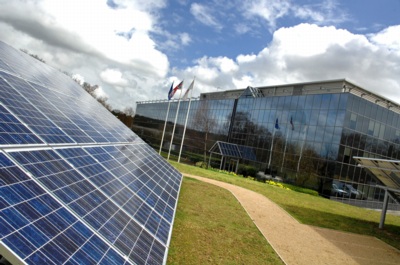How low can you go?

For several years Mitsubishi Electric has been making steady and progressive reductions to the carbon footprint of its headquarters at Hatfield, with a dramatic effect on the Energy Performance Certificate. Martin Fahey shares his experiences.
The Government has set very specific UK carbon-reduction targets, and with buildings accounting for 44% of all UK greenhouse gas emissions (more than industry or transport) everyone involved in the built environment has an important role to play in meeting these targets.
As a major part of the problem, buildings have to become part of the solution. Through legislation, incentives and increasingly aware individuals, Government and corporate energy users are all demanding change.
We are now creating new buildings that have a much lower carbon footprint and which use energy in a much more efficient way. Whilst important, the rate of new-build is simply too slow to make a dramatic difference.
It is also estimated that at least 75% of our existing buildings will still be in use in 2050, so to a large degree our future is already built, and we have to find ways of tackling these old and energy inefficient properties.
As the nation faces the triple challenge of climate change, fuel security and rising energy costs, finding ways of improving the efficiency of existing buildings can help make a dramatic difference.
Changes to lower the carbon footprint of a building can often be achieved in cost-effective ways, such as better insulation or more control over the timing and use of energy-consuming equipment.
The advice in the home is to turn the thermostat down a bit and the same applies in the commercial sector, where more centralised control of air conditioning and heating can have a significant impact on fuel bills and CO2 emissions.
Once you have implemented these small step changes and looked at improving the thermal properties of a building, what else can you do to head towards a zero-carbon building?
Upgrading the fabric of a building is generally seen as a good move before employing renewable technologies. However, for many companies, such upgrading may simply not be possible without enormous disruption, possibly even calling for a building to be vacated.
As a manufacturer of renewable and energy-efficient technologies, Mitsubishi Electric has looked at ways of reducing the carbon footprint of its Hatfield headquarters.
This has seen the company improve the energy rating of its 1980s, glass-fronted, 3-storey office block from a benchmark Energy Performance Certificate of ‘E’ to a ‘B’, a change that has come about through an evolutionary, rather than a revolutionary approach.
Like all companies we have to justify capital expenditure, yet at the same time we wanted to show what could be done with existing technologies. What we have therefore done is put in place an ad hoc programme of upgrading building services when they needed replacement or when additional budget became available.

I believe that this approach is typical of most companies and that they can therefore be persuaded to invest in renewable technologies and make a real difference to their carbon footprint.
Our Hatfield office was typical of a 1980s office block, with a chiller pumping out chilled water and a gas boiler for heating. When Mitsubishi Electric started to investigate different options over eight years ago, out went the chiller and in came VRF heat-recovery air conditioning to heat and cool in a more balanced approach, while recovering heat for use in other parts of the building.
This has been added to over the years, with the addition of a ground-source VRF system and heat pump for the generation of hot water, including a system which now uses excess heat from the kitchen to preheat water for washing up.
The company then installed a small ground array of solar PV. which has now been added to with a 220-panel, 40 kW array on the roof. This is one of the improvements that has helped the building achieve a ‘B’ EPC.
There are more things we can and are doing, such as update the lighting as we refurbish individual parts of the building. PIR sensors, for example, can be used to ensure that lights only come on in occupied areas.
However, we know that we are highly unlikely ever to get the building to reach an ‘A’ rating without radical overhaul of the overall fabric, and this may simply be a step too far in terms of cost and disruption to the business. Zero carbon may simply not be possible for many of our existing buildings.
Whilst further improvement is possible, the building is now vastly improved and points to what individual companies can realistically achieve in practical and financial terms.
In taking a ‘standard’ office block to a ‘B’ EPC, we have demonstrated that big improvements can be made readily and easily through small and manageable changes to existing building stock.
Regardless of the zero-carbon ideal, getting more businesses to replicate our success over time can help existing buildings make a considerable difference to the nation’s energy performance.
Martin Fahey is sustainable-solutions manager with Mitsubishi Electric.








